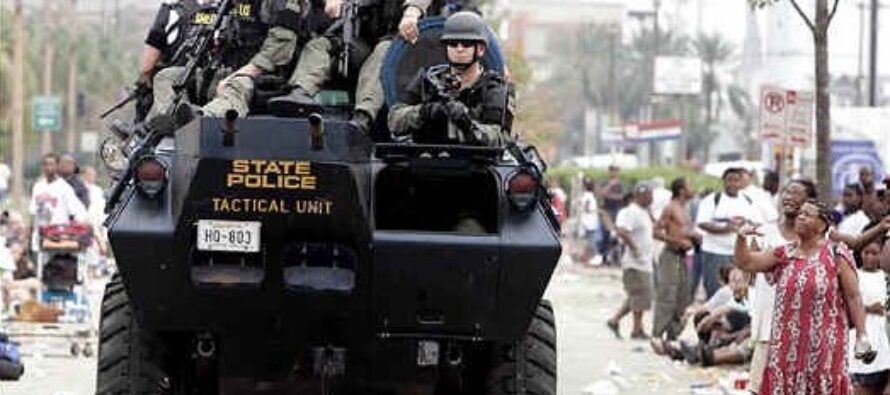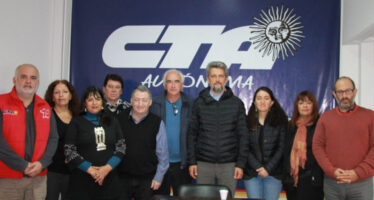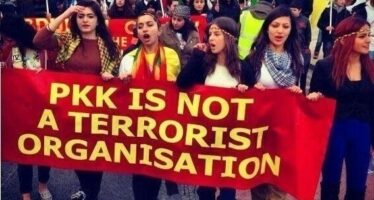Overkill: How the Pentagon Militarized the US Police Force

![]()
“Have no doubt, police in the United States are militarizing, and in many communities, particularly those of color, the message is being received loud and clear: ‘You are the enemy,’” writes Tom Nolan, who worked for 27 years in the Boston Police Department. “Many communities now look upon police as an occupying army, their streets more reminiscent of Baghdad or Kabul than a city in America.”
This is no coincidence; much of the equipment used by police forces on the streets of America today is in fact directly from the US military.
From a weaponization bonanza enabled by a little-known Pentagon program, to an escalation in SWAT team deployments, the militarization of the US police force poses an increasing threat to the American public, as recently exhibited in Ferguson, Missouri.
Behind this militarization is the Pentagon’s “1033 program,” created in the National Defense Authorization Act for 1997, which enables the Defense Department to provide surplus military equipment at a highly reduced cost to local police departments. The program was expanded after 9/11, and has led to the distribution of $4.2 billion in equipment. Police departments across the country now utilize some 500 military aircraft, 93,763 assault weapons and 432 Mine-Resistant Ambush Protected military vehicles – which cost around $700,000 new, and are being sold to police departments for as low as $2,800.
An example of the program cited by The Guardian pointed to a Richland County sheriff in South Carolina obtaining a tank with 360-degree rotating machine gun turrets. The tank was named “The Peacemaker.”
Such unnecessary equipment is being utilized in cities and small towns across the country without sufficient oversight, proper training, or public input.
Following the outcry over police violence in Ferguson, the Pentagon still maintains that the weapon-selling program is for the public good. As Pentagon spokesman John Kirby told Newsweek, “This is a useful program that allows for the reuse of military equipment that would otherwise be disposed of, that could be used by law enforcement agencies to serve their citizens.”
However, rather than serving citizens, this militarization of the police force has contributed to unnecessary violence, primarily against people of color and under the pretext of the so-called war on drugs.
In June of this year, the American Civil Liberties Union (ACLU) released a comprehensive report entitled “War Comes Home: The Excessive Militarization of American Policing,” which concludes that the US police force has become “excessively militarized through the use of weapons and tactics designed for the battlefield” and that this alarming trend “unfairly impacts people of color and undermines individual liberties, and it has been allowed to happen in the absence of any meaningful public discussion.”
While this escalation is ostensibly aimed at protecting the population from violent threats, the ACLU found that 62% of the SWAT raids examined were used to search for drugs, while only 7% were used for “for hostages, barricade, or active shooter scenarios.”
The use of SWAT teams has been skyrocketing over the past 45 years, according to Professor Peter Kraska of Eastern Kentucky University’s School of Justice Studies. In the 1970s, they were used only a few hundred times a year; now they’re deployed about 50,000 times annually, Kraska estimates. In some cases, they’ve even been used to break up illegal poker games, unlicensed barber shops and under-age drinking. In the case of Jesus Llovera, a suspected organizer of cockfights in Maricopa County Arizona, in 2011 a SWAT team took over the man’s living room, and drove a tank into his yard, killing his dog and over 100 of his chickens.
Highlighting the fact that this militarization is part of a wider assault of people of color in America, Alex Kane points out in Alternet that this violence is tied to the “war on undocumented immigrants.” Kane cites the ACLU’s report on Arizona’s infamously anti-immigrant sheriff Joe Arpaio, who, in addition to acquiring five armored vehicles and ten helicopters, has “a machine gun so powerful it could tear through buildings on multiple city blocks.”
One step in the right direction following police violence in Ferguson would be to demilitarize the US police force. As an unnamed Ferguson resident recently told the BBC about his city’s police officers: “It’s power. They have the power, they feel we don’t. That’s why they do the things that they do. What they did to young Michael Brown, that’s unnecessary. That’s overkill.”
***
Benjamin Dangl is a doctoral candidate in Latin American History at McGill University, and the author of the booksDancing with Dynamite: Social Movements and States in Latin America, and The Price of Fire: Resource Wars and Social Movements in Bolivia. He edits UpsideDownWorld.org, a website on activism and politics in Latin America, andTowardFreedom.com, a progressive perspective on world events. Twitter: @bendangl
Related Articles
HDP deputies touring Argentina
![]()
HDP deputies Ebru Gunay and Gato Paylan visited the Central of Workers of Argentina (Autonomous CTA) after the conference they gave in a packed room in the Senate
“PKK IS NOT A TERRORIST ORGANIZATION!”
![]()
Murat Güleryüz, human rights activist and Rojava Support campaigner has started a petition to the US State Department to have the PKK delisted in the U.S. as a terrorist organisation
TURKEY: More Walls…Less Peace
![]()
Turkish President and Chairman of the ruling Justice and Development Party Recep Tayyip Erdoğan announced plans, at the end of May, to construct walls to the south and south-east with neighbours Iraq and Iran





